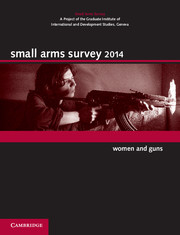Book contents
- Frontmatter
- Foreword
- Contents
- About the Small Arms Survey
- Notes to readers
- Acknowledgements
- Introduction
- Chapter 1 In War and Peace: Violence against Women and Girls
- Chapter 2 Converging Agendas: Women, Peace, Security, and Small Arms
- Special Feature. Women behind the Gun: Aiming for Equality and Recognition
- Chapter 3 Breaking New Ground?: The Arms Trade Treaty
- Chapter 4 Trade Update: Transfers, Retransfers, and the ATT
- Chapter 5 Countdown to Catastrophe: The Mpila Ammunition Depot Explosions
- Chapter 6 Across Conflict zones: Ammunition Profiling
- Chapter 7 Signs of Supply: Weapons Tracing in Sudan and South Sudan
- Chapter 8 On the Record: Illicit Weapons in the the United States
- Index
Chapter 3 - Breaking New Ground?: The Arms Trade Treaty
Published online by Cambridge University Press: 05 July 2014
- Frontmatter
- Foreword
- Contents
- About the Small Arms Survey
- Notes to readers
- Acknowledgements
- Introduction
- Chapter 1 In War and Peace: Violence against Women and Girls
- Chapter 2 Converging Agendas: Women, Peace, Security, and Small Arms
- Special Feature. Women behind the Gun: Aiming for Equality and Recognition
- Chapter 3 Breaking New Ground?: The Arms Trade Treaty
- Chapter 4 Trade Update: Transfers, Retransfers, and the ATT
- Chapter 5 Countdown to Catastrophe: The Mpila Ammunition Depot Explosions
- Chapter 6 Across Conflict zones: Ammunition Profiling
- Chapter 7 Signs of Supply: Weapons Tracing in Sudan and South Sudan
- Chapter 8 On the Record: Illicit Weapons in the the United States
- Index
Summary
INTRODUCTION
‘[T]he world has decided to finally put an end to the free-for-all nature of international weapons transfers’, UN Secretary-General Ban Ki-moon asserted when the Arms Trade Treaty (ATT) opened for signature on 3 June 2013 (UNDPI, 2013b). Sixty-seven countries signed the treaty during the signing ceremony at UN Headquarters in New York that day, with states continuing to sign—and in several cases ratify—the ATT at a brisk pace during the last half of 2013. To date, UN member states have demonstrated broad support for the ATT, suggesting that they see it as a game changer.
In fact, different stakeholders perceive different benefits as arising from the ATT. For some, it is a means of levelling the playing field and ensuring that emerging arms exporters and those that do not already participate in existing export control regimes are subject to international norms and standards. For others, it represents a chance, through a legally binding instrument, to fulfil the promise of the UN Programme of Action (PoA) to curb the illicit small arms trade. For others, it is the beginning of the end of the human suffering brought about by irresponsible arms transfers. As the excitement following the adoption subsides, the question becomes: what does the ATT do and what will it change?
The central aim of the treaty is to establish the highest possible common international standards to regulate the international trade in conventional arms.
- Type
- Chapter
- Information
- Small Arms Survey 2014Women and Guns, pp. 76 - 107Publisher: Cambridge University PressPrint publication year: 2014



